Shooting Movies (b Mode)
b (auto) mode can also be used for simple, “point-and-shoot” movie recording.
-
Turn the camera on.

The monitor turns on.
-
Select movie mode by rotating the photo/movie selector to 1.
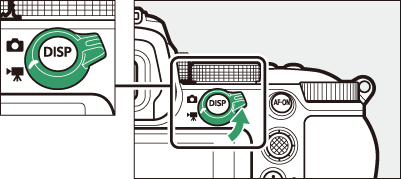
Note that optional flash units cannot be used when the camera is in movie mode.
-
Rotate the mode dial to b.
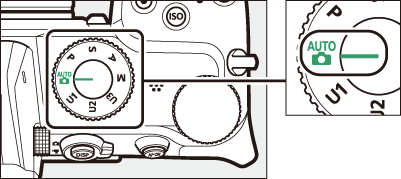
-
Press the movie-record button to start recording.
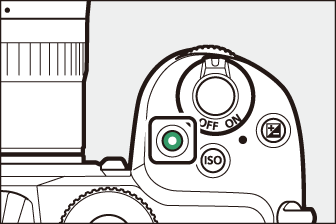
-
A recording indicator will be displayed in the monitor. The monitor also shows the time remaining, or in other words the approximate amount of new footage that can be recorded to the memory card.
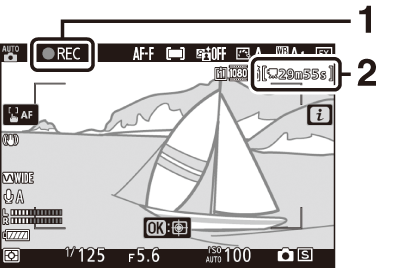
1 Recording indicator
2 Time remaining
-
The camera can be refocused during recording by pressing the AF‑ON button.
-
Sound is recorded via the built-in microphone. Do not cover the microphone during recording.
-
If you tap your subject in the monitor during recording, the focus point will track the subject as it moves through the frame (Subject-Tracking AF).
-
-
Press the movie-record button again to end recording.

The memory card access lamp will light while the photograph is being recorded. Do not remove the memory card or battery.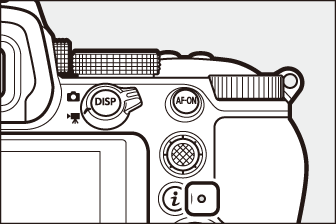
Taking Photos in Movie Mode
Photos can be taken in movie mode by pressing the shutter-release button all the way down. The release mode (single-frame or continuous) can be selected before shooting begins using the c (E) button.
-
A C icon will flash in the display when a photo is taken.
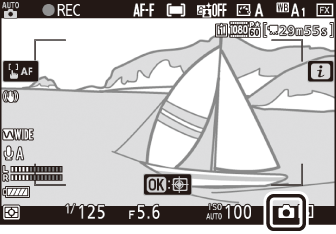
-
The frame advance rate for [] release mode varies with the option selected for [].
-
Photos can be taken while recording is in progress. Taking photos does not interrupt movie recording. Note, however, that only one photo will be taken each time the shutter-release button is pressed, even if [] is selected for release mode.
A 0 icon indicates that movies cannot be recorded.
-
Movie recording will end automatically if:
-
The maximum length is reached
-
Another mode is selected
-
The photo/movie selector is rotated to C
-
The lens is removed
-
-
Sounds made by the camera may be audible in footage recorded:
-
During autofocus
-
During vibration reduction
-
When power aperture is used
-
-
Photo-mode settings do not apply to photos taken in movie mode.
-
Up to 40 photographs can be taken with each movie.
-
Note that photos can be taken even when the subject is not in focus.
-
Photos are recorded at the dimensions currently selected for movie frame size.
-
Photos are recorded in [] format, regardless of the option selected for image quality.
-
Photos taken during movie recording are saved to the memory card in the slot selected for [] in the movie shooting menu or in the i menu for movie mode.
-
A N icon indicates that photos cannot be taken.
-
You may notice the following in the shooting display. These phenomena will also be visible in any photos or footage recorded with the camera.
-
Flicker or banding in scenes lit by such sources as fluorescent, mercury vapor, or sodium lamps
-
Moving objects in the display appear distorted (individual subjects such as trains or cars moving at high speed through the frame may be distorted, or the entire frame may appear distorted when the camera is panned horizontally)
-
Jagged edges, color fringing, moiré, and bright spots may appear in the display
-
Bright regions or bands may appear in scenes lit by flashing signs and other intermittent light sources or when the subject is briefly illuminated by a strobe or other bright, momentary light source
-
Flicker occurring when power aperture is used during movie recording
-
-
Note that noise (randomly-spaced bright pixels, fog, or lines) and unexpected colors may appear if you use the X button to zoom in on the view through the lens during filming.
-
When recording, avoid pointing the camera at the sun or other strong light sources. Failure to observe this precaution could result in damage to the camera’s internal circuitry.
